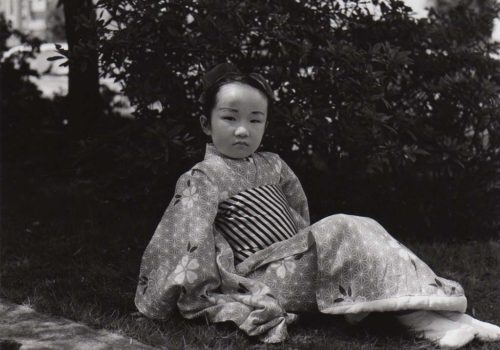Galerie Priska Pasquer presents the second exhibition featuring the works of Japanese photo artist Issei Suda. The photographs on display are from Issei Suda’s key work “Fushi Kaden”, which was originally published in 1978 and reprinted last year.
The exhibition features large-scale vintage prints, unique specimens in this form. The “Fushi Kaden” works are accompanied by smaller-scale photographs from the “Human Memory” series published in 1980. The exhibition title “The Transmission of the Flower or Acting Style” is a direct translation of the words “Fushi Kaden”.
In the early 1970s, Issei Suda began to capture impressions of predominantly rural festivals (known as “Matsuri”) with his camera. Unlike Provoke artists such as Shomei Tomatsu, who preferred raw, dynamic images, Issei Suda used a medium format camera to take these pictures. This approach gave rise to concentrated image forms, in which the depicted individuals and views took centre stage. Owing in part to the slower nature of the photographic technology used, the subjects of the portraits were able to ready themselves for being photographed. The pictures show them as rigid as sculptures, decked out in festive finery as though they were actors in an unknown play.
Issei Suda’s perception of such surroundings was influenced by the legendary avantgarde theatre group “Tenjo Sajiki”, led by Shuji Terayama. From 1967 onwards, Suda was the group’s theatre photographer. In 1968, a book about the acting troupe was published containing photographs by Issei Suda and Daido Moriyama. Suda’s work with Shuji Terayama was the catalyst to his exploring “Fushi Kaden”, a treatise written by Japanese Noh theatre master Zeami (1363-1443) in the early 15th century. In this treatise on the aristocratic Noh theatre, Zeami examines in very great depth the metaphor of the flower, a firmly established symbol in Japanese culture. He compares the aesthetic principle of growth with that of the ever-changing blossom. Creative force comes about through the beauty and sensuality of a blossom – also a symbol for youth – and through the repetition of the familiar, which is skilfully woven together with unknown elements. That which resonates unseen fills the scene with new life: “If hidden, acting shows the Flower; if unhidden, it cannot” (Zeami).
Issei Suda’s photographs are shaped by an aesthetic of time standing still, thus reflecting the medium of photography itself, which can only ever capture a single moment, but never the flow of time. With their festive clothing and poses, the depicted individuals and scenes are far removed from everyday reality. The shots are given a slightly surreal, undefinable character. The photography becomes a stage with conscious or unconscious actors who, through Suda’s photographs, become part of a world of art: “The matter-of-factness of Suda’s photography gives a sense of balance and detachment while at the same time suggesting an otherworldliness.” (Ryuichi Kaneko)
Along with the photographs from the series “Fûshi Kaden,” the exhibiton includes works from the ’70s and ’80s from the book “Human Memory.” In this series published in 1996 Suda concentrates especially on people in the city. Here as well, our attention is drawn to the extraordinary aspects of the everyday, showing the author’s particular perception of the world.
Issei Suda, born 1940 in Tokyo, lives today in Chiba. Studied at Tokyo College of Photography until 1962. From 1967 he was stage photographer for the Avantgarde Theater group „Tenjo Sajiki“, which was under the direction of the poet and playwright Shuji Terayama. In 1971he became independent photographer,then 1991-1997 operator of the Haranagacho-bashi Gallery,and Professor at Osaka University of Arts.
Issei Suda: The Transmission of the Flower of Acting Style
Exhibition: May 18 – June 29, 2013
Galerie Priska Pasquer
Albertusstraße 9
50667 Köln
Germany
+49 221 9526313
















